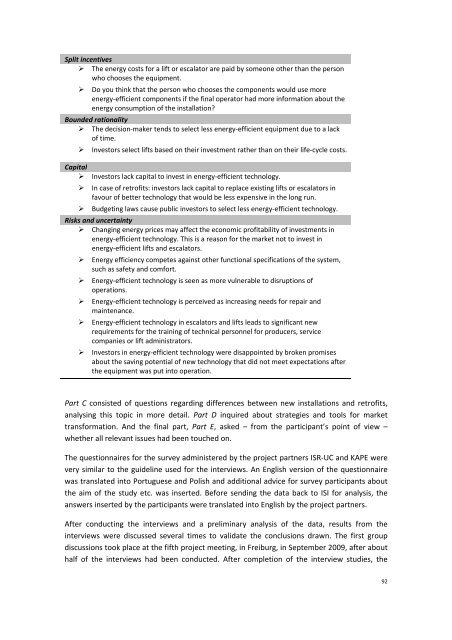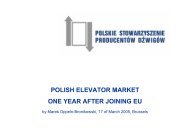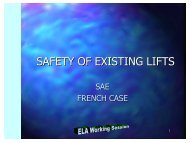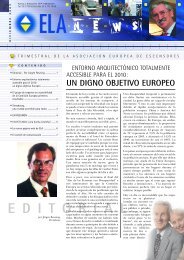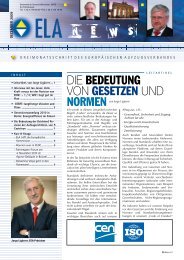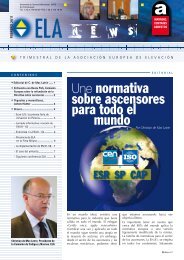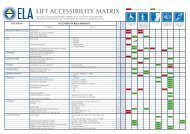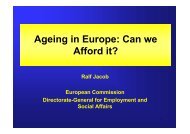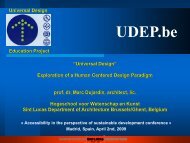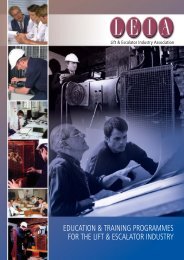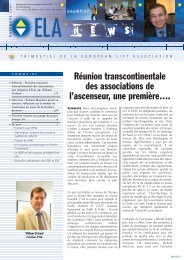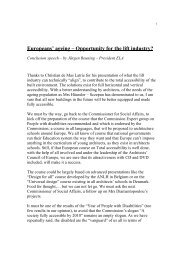WP6-Brochure-E4 brochure - ELA European Lift Association.
WP6-Brochure-E4 brochure - ELA European Lift Association.
WP6-Brochure-E4 brochure - ELA European Lift Association.
You also want an ePaper? Increase the reach of your titles
YUMPU automatically turns print PDFs into web optimized ePapers that Google loves.
Split incentives<br />
‣ The energy costs for a lift or escalator are paid by someone other than the person<br />
who chooses the equipment.<br />
‣ Do you think that the person who chooses the components would use more<br />
energy‐efficient components if the final operator had more information about the<br />
energy consumption of the installation<br />
Bounded rationality<br />
‣ The decision‐maker tends to select less energy‐efficient equipment due to a lack<br />
of time.<br />
‣ Investors select lifts based on their investment rather than on their life‐cycle costs.<br />
Capital<br />
‣ Investors lack capital to invest in energy‐efficient technology.<br />
‣ In case of retrofits: investors lack capital to replace existing lifts or escalators in<br />
favour of better technology that would be less expensive in the long run.<br />
‣ Budgeting laws cause public investors to select less energy‐efficient technology.<br />
Risks and uncertainty<br />
‣ Changing energy prices may affect the economic profitability of investments in<br />
energy‐efficient technology. This is a reason for the market not to invest in<br />
energy‐efficient lifts and escalators.<br />
‣ Energy efficiency competes against other functional specifications of the system,<br />
such as safety and comfort.<br />
‣ Energy‐efficient technology is seen as more vulnerable to disruptions of<br />
operations.<br />
‣ Energy‐efficient technology is perceived as increasing needs for repair and<br />
maintenance.<br />
‣ Energy‐efficient technology in escalators and lifts leads to significant new<br />
requirements for the training of technical personnel for producers, service<br />
companies or lift administrators.<br />
‣ Investors in energy‐efficient technology were disappointed by broken promises<br />
about the saving potential of new technology that did not meet expectations after<br />
the equipment was put into operation.<br />
Part C consisted of questions regarding differences between new installations and retrofits,<br />
analysing this topic in more detail. Part D inquired about strategies and tools for market<br />
transformation. And the final part, Part E, asked – from the participant’s point of view –<br />
whether all relevant issues had been touched on.<br />
The questionnaires for the survey administered by the project partners ISR‐UC and KAPE were<br />
very similar to the guideline used for the interviews. An English version of the questionnaire<br />
was translated into Portuguese and Polish and additional advice for survey participants about<br />
the aim of the study etc. was inserted. Before sending the data back to ISI for analysis, the<br />
answers inserted by the participants were translated into English by the project partners.<br />
After conducting the interviews and a preliminary analysis of the data, results from the<br />
interviews were discussed several times to validate the conclusions drawn. The first group<br />
discussions took place at the fifth project meeting, in Freiburg, in September 2009, after about<br />
half of the interviews had been conducted. After completion of the interview studies, the<br />
92


